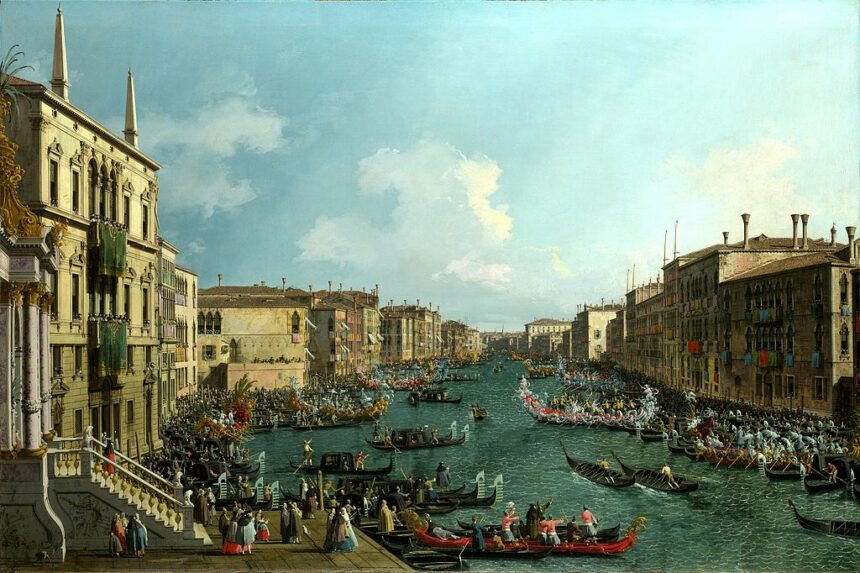In addition to modern events and the numerous festivals during the year in Venice, these are the classic Venetian events
FESTA DELLA SALUTE
Since 1631, every 21st November the emotional, great pilgrimage of the Venetians (people and authorities) to the votive temple of S. Maria della Salute is repeated, wanted by the Serenissima as a sign of gratitude for the liberation of Venice from the plague. A temporary bridge on boats is launched on the Grand Canal to allow the imposing crowd to reach the church and light the candles of hope in front of the image of the black Madonna, called the “Mesopanditissa” (mediator of peace) brought to Venice in 1672, after the war in Candia, by Francesco Morosini.
FEAST OF “SENSA”
On Ascension Day (while the statues of the Three Wise Men appear on the Clock Tower, at every striking of the hours) with a ritual in S. Nicolò di Lido, Venice remembers the “marriage of the sea” when the doge, on board the Bucintoro threw his ring into the sea, saying: «We marry you, O sea, as a sign of eternal dominion ››. For some years now, the now famous Vogalonga has also been implemented, which attracts boats of all types (even large cargo boats, heavy Peate with 14 20 oars) for this non-competitive 30 km round trip in the lagoon.
REDENTORE FEAST
It is the fairytale boat party on Saturday that proceeds on the third Sunday of July. It is renewed every year, since 1577, that is, since, after the terrible plague that had hit the city, the Venetians began the construction of the Church of the Redeemer in Giudecca, the work of Palladio. During the day, there is a votive pilgrimage, while at sunset the famous night party begins which lasts until dawn. The basin of S. Marco collects thousands and thousands of boats, in a blaze of lights, colors, music, on the ground a huge crowd witnesses the fire, the midnight fireworks display that concludes the first part of the party. Then, the boats swarm to the Lido to wait (as tradition dictates) for the sun to rise, between songs and dances.
S. MARCO FEAST
On April 25, Venice commemorates and honors the patron Saint Mark with solemn functions and a concert of sacred music in the basilica must, under the main altar, preserve the body of the evangelist. According to a gentle custom, on the day of S. Marco there is also the feast of the bacolo: as a sign of love, the Venetians offer their women a rosebud purchased in one of the numerous kiosks set up in the square and nearby streets.
SUMMER MUSICAL EVENTS
In the courtyard of the Palazzo Ducale, where prose shows are sometimes organized, symphonic concerts are performed, normally every Monday, in the months of July and August. In the same months (on Wednesdays) soloists and ensembles from all over the world perform organ concerts in the basilica of S. Marco. The closing concert is generally held at the Marciana Chapel, the famous complex of the basilica which has 700 years of history behind it and which was directed, among others, also by Claudio Monteverdi and Lorenzo Perosi.
CAMPIELLO AWARD
One of the greatest events of the Italian literary season, the Campiello Prize owes its success to the originality of the formula. Among the works of Italian fiction published during the year, in the spring a jury of critics chose five authors, then entrusted their fate to a large jury of three hundred “non-professional” readers, ie workers, students, doctors, housewives, actresses , lawyers. The final sentence is up to these three hundred unknown judges who, with their ballots, choose the winner. The awarding takes place on the evening of the first Saturday of September, in the Doge’s Palace.
HISTORICAL REGATTA
On the first Sunday of September, Venice celebrates one of its most ancient and glorious festivals: the Historical Regatta which, every year since 1300, draws on the banks of the Grand Canal (festively paved with tapestries and damasks), a large crowd of Venetians and tourists . After the procession of the picturesque flotilla of the bissone, sumptuous boats conducted by gondoliers in 15th century costumes, the 2-row gondolini race takes place. The Historical Regatta, however, is much more than a simple sporting competition: it is a people’s festival, a celebration in which the gondola, symbol of the soul and tradition of Venice, is the real protagonist.
 BIENNIALE
BIENNIALE
The Public Gardens, commissioned by Napoleon at the beginning of the nineteenth century, were soon considered suitable for hosting an International Biennial Art Exhibition conceived by a group of intellectuals who met at the Caffè Florian. The first review was inaugurated on March 30, 1895, with great critical and public success. Over a hundred years later, despite numerous difficulties, the Venice Biennale Authority (with a new statute) continues its initiatives in the more traditional sectors (cinema, theater, music and visual arts) and in the more advanced ones, mass media, art tapes and video art.


